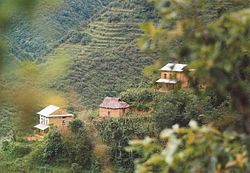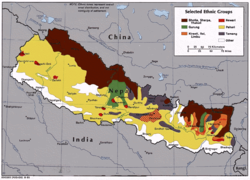- Tamang people
-
The Tamangs (Devnagari: तामाङ; tāmāng) are the ancient and original inhabitants of the mountains and plains of the Himalayan regions of Nepal and India. Their ancient capital being Yambu - modern day Kathmandu. They have their own distinct culture, language and religion. Their ancestral domain (land) is popularly known as Tamsaling. Tamsaling extends from Buddigandaki in the West to Dudhkoshi in the East and from the Himalayan range in the North to Chure or Siwalik hills in the South. ‘Tam’ refers to the language spoken by Tamang people, ‘sa’ refers to the land and ‘ling’ refers to the territory or fragment. So, ‘Tamsaling’ mean the land of Tamang tonguespeaking people. Through the centuries, due to foreign invasions, they moved to other parts of South Asia. Today, they inhabit practically the entire mountainous regions of Nepal and also adjoining regions of India, Myanmar, Bhutan, and Tibet.
In Nepal, Tamangs are predominately found in the districts of Sindhupalchowk, Rasuwa, Kathmandu, Bhaktapur, Lalitpur, Dhading, Makwanpur, Nuwakot, Ramechhap, Dolakha, Chitwan and Kavreplanchowk. A small number of Tamang who migrated from Nepal can also be found in the hilly regions of India. Living mainly in the north and east of the country, they constitute 5.6% of Nepal's population, which places their population at 1,280,000, slightly higher than the Newars.
Tamang are rich in socio-cultural perspectives. They are the only indigenous nationalities who are least affected by the process of Nepalization. As a result of their success to maintain their distinct identity despite the state sponsored process of Nepalization they are highly marginalized and exploited by the state. Extensive poverty and illiteracy are found in large scale. They are very rich in their culture but their economic condition is worse. Even after the restoration of Democracy in 1990, their economic status has not been changed.
Many Tamang clans do not permit intermarriage with other ethnic groups, although some clans do permit intermarriages with the Gurung, Magar, Kiats, and Sherpas. Their descent is traced patrilineally.
Contents
History
The Tamanga are a very ancient tribe of Nepal and are the original people of Yambu (Kathmandu Valley). Nepalese history states that the Enlightened Manjushree made an ancient abode of Tamang in Yambu. The ancient Tamang song - “Gyanaka Gyamse Phepkaziam" or "Appeared from China” says that the oldest tribe of Yambu is Tamang. There are dense Tamang settlements around Yambu even today.
According to the version of the Dynasty of Nepal and Dr. Shetenkoko, Tamangs are the oldest tribe of Nepal. Dr. Anatoly Yakoblave Shetenko visited Nepal on an archaeological study programme under an agreement between Nepal and USSR. He discovered that the tools, weapons and artifacts that date back to the Stone Age (about 30,000 B.C.) at Budhanilkantha were the same as those found in Govy of Mongolia, Asia, and America. Presently such Mongolian artifacts dating back to the Stone Age are found in Yambu (Kathmandu, Budhanilkantha) which prove that the Mongolians (Tamangs) came by way of Tibet and the Himalayas to Nepal. It is evident that the Mongols were settled in Yambu (Kathmandu Valley) from the north more than 30,000 years ago. According to Janak Lal Sharma, "those Mongols that came from the north are today’s Tamangs." [1]
Earlier Tamangs were known by various terminologies. Among these, ‘Murmi’ is a popular term. Hamilton in 1802, Hudson in 1847, and Macdonald in 1989 have used the term ‘Murmi’ for Tamang people. Some scholars are of the opinion that during the regime of King Tribhuvan the then Prime Minister Bhim Shumsher had formally used the term ‘Tamang’ for the very first time under the request of Sardar Bahadur Jungabir, who was also from the Tamang nationality. In 13th century, King Boom Degon (1253-1280), who had ruled the present Mustang region of Nepal, has scriptured the word ‘Tamang’ in his genealogy. This is the oldest written document ever found about the usage of the word ‘Tamang’ that exclusively refers to the Tamang nationality of Nepal.
There still prevails differences about the origin of the word ‘Tamang’. A common belief is that the word ‘Tamang’ has been derived from a Tibetan word "Tamag” which means ‘Ta’ referring to ‘horse’ and ‘Mag’ referring to ‘rider’. So Tamang are the ‘horse-riders or soldiers riding on horse. It is believed that after the Nepal-Tibet War some of the horse-riding soldiers of King Tsrong Tschong Gampo permanently settled in the Himalayan Hills of Nepal who were later recognized as the “Tamang” nationalities. But many scholars have opposed the above perspective that the Tamangs are the descendants of the horse-riding soldiers of King Tsrong Tschong Gampo. A foreign scholar Alexander MacDonald is one among them. According to him, Tamangs are the indigenous inhabitants of Nepal who were here before the state formation. He disagrees that Tamangs are the horse-riding soldiers of King Tsrong Tschong Gampo who were left behind after the Nepal-Tibet War. He puts forward his reasoning that there should be some mention of King Gampo in the genealogy of Tamang nationality if it was so. But nothing has been found yet.
In their language, the Tibetans call Tamang people ‘Rongpo’ which means 'foreigners'. Obviously, it also justifies that Tamangs are the indigenous inhabitants of Nepal, not the horse-riding soldiers of King Tsrong Schong Gampo. A young scholar Ajitman Tamang redefines the Tibetan perspective of the word ‘Tamang’. He is of the view that in Tibetan ‘Ta’ means ‘entrance/gateway’ and ‘Mang’ means ‘large public or common people’. So, ‘Tamang’ in Tibetan means presence of large number of people at the entrance or boundary, which signifies the settlement of Tamang people in the border of Tibet i.e. in Nepal. It is also supported by the Tibetan usage of the word ‘Rongpo’ to Tamang, which means the foreigners, inhabited beyond the border of Tibet. Now it is obvious that the Tamangs are the indigenous inhabitants of Nepal, not the descendants of the horse-riding soldiers of King Tsrong Tschong Gampo as Tamang themselves do not possess the characteristics of a horse rider nor there a sign of their history directly associated with horses. Usage of the word ‘Tamang’ It is still in the root of the research from when the word ‘Tamang’ has been in use to refer to the Tamang nationality of Nepal.
Population Distribution
Tamang are one of the largest indigenous ethnic groups of Nepal. Tamang indigenous peoples comprise 5.6% of the total population of the country. The census of 2001 has traced a population of 1,282,304 Tamangs in Nepal, ranking the fifth position in the country and the third among the indigenous nationalities. They are found mostly concentrated in the districts of the central region such as Dhading, Rasuwa, Makwanpur, Nuwakot, Kavrepalanchok, Sindhupalchok, Dolkha, Sindhuli and Ramechhap. Tamang are the largest population in all of the aforementioned districts except in Ramechhap and Dolkha, where they are the second largest. The other parts of the country from Mechi to Mahakali regions observe a sparse distribution of the Tamang population.
Religion
The Tamangs are the largest population to follow Buddhism in Nepal. According to the census of 2001, 90.3% of the Tamangs follow Buddhism, which makes up 47.3% of the total in the country. Among the others who follow Buddhism in Nepal 16% are Magar, 15% are Gurung, 8% are Newar, 6% are Sherpa and the remaining are others.
The Tamang people originally practiced Bonism, or ancestor worship, but living in proximity to the Tibetans, became Buddhists when Buddhism spread in Tibet and were one of the earliest communities to do so. The findings in Mustang of viharas (Buddhist monasteries) and caves, known as the Ajanta Caves, also prove this point. Ancestors and many deities and guardians are worshipped there, - the deities of khappa soong, foopshang, mraap soong, family deity, clan deity, place deity, etc...
Language
Tamang people have their own mother tongue i.e. Tamang. The census of 2001 has traced 92% of the Tamang people speak Tamang.
Tamangs have their own distinct language. Their mother tongue is Tamang, which falls in Tibeto-Burman language group. According to the census of 2001, 92% of the Tamang people speak in their own mother tongue i.e. Tamang. Their script is known as Sambhota, but one of the leading Tamang organizations, Nepal Tamang Ghedung, has been using a script known as Tamyig well known as a modified version of the Sambhota script.
See also
External links
[www.TamangFamily.com], Tamang Society of America, Tamang Friendship, World Tamang's Social Network
- Tamang Samaj, Biggest Tamang Portal around the World. Get All Information about Tamang from these site.
- Lesson 10: The Newars and the Tamang
- General Profile about the Tamangs
- [1]
- Tamang People
- http://www.tamangs.com
- http://www.magarstudiescenter.org/pop-tamang.php
- '^ Book of Thu:Chen Thu:Jang, by Moktan Dupwangel Tamang, 1998
Categories:- Buddhist communities
- Ethnic groups in Nepal
- Social groups of West Bengal
- Tribes of West Bengal
Wikimedia Foundation. 2010.


